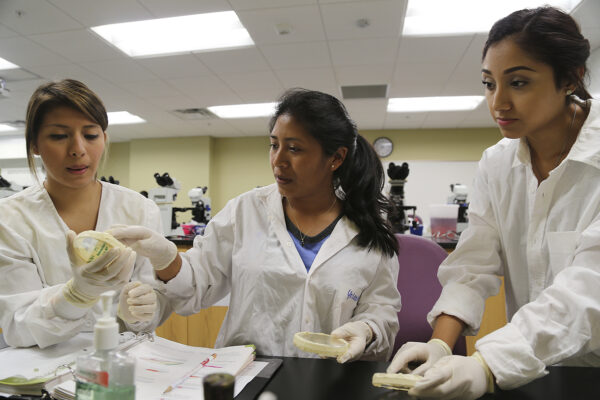Anne-Marie Nuñez suggests looking to Hispanic-Serving Institutions as a model for how to build an inclusive campus racial climate. This is the second in a series sparked by recent student protests and the national dialogue on diversity and inclusion.
Although protests over campus racial climate dominated the headlines in 2015, racism—both individual and structural—is a long-standing problem in higher education just as in American society at large.
Many institutions do collect data on campus racial climate, and that collection is often a critical first step to improving conditions. However, as scholars Marybeth Gasman and Shaun Harper noted recently, even when presented with hard data, many leaders remain unaware of the extent of racial problems on campus, or they simply choose not to take action unless there is a crisis.
Minority-Serving Institutions have great potential to teach us lessons about what campuses can do to improve the racial and ethnic climate, as these institutions have been serving students of color for years. Furthermore, unlike selective public institutions, which face difficulties enrolling diverse student bodies in the face of legal challenges to the use of diversity in admissions, most Minority-Serving Institutions prioritize a mission of access for all students.
As institutions that enroll the majority of Latino students (60 percent), Hispanic-Serving Institutions (HSIs) can provide insights about how to serve the largest growing demographic group in the United States. HSIs are institutions that enroll at least 25 percent Latino full-time undergraduate students. The average HSI also enrolls about half students from low-income backgrounds.
A fundamental pillar of creating a supportive campus climate is encouraging a racially and ethnically diverse student composition, and many HSIs enroll a large share of minority students from diverse groups. Research has found that students at campuses with higher concentrations of students of color (such as those at HSIs) also report fewer incidents of stereotyping and discrimination. Both in and out of the classroom, these students are less likely to feel isolated and to perceive that they are tokens who must represent their race. However, studies also indicate that a diverse campus composition is not enough to create a welcoming campus climate.
Another pillar of creating a supportive campus climate is building conditions for curricula that are responsive to the realities of students of color instead of dominant narratives that tend to exclude non-white perspectives. Faculty at HSIs are more likely than others to use student-oriented pedagogies in their teaching and to be involved in the community, both of which foster a better campus climate for students of color. Furthermore, HSIs tend to have higher representations of Latino faculty, who can serve as examples of pathways to graduate school. (See chapter 2 of Hispanic-Serving Institutions: Advancing Research and Transformative Practice.)
Along this line, it is critical to increase the recruitment and retention of underrepresented faculty so that all students have access to professors from different backgrounds as role models. Notably, the argument is often made that there are not enough Ph.D.’s of color to diversify the faculty at every college and university—the “pipeline” argument. But faculty of color are not always specially sought out for professorial positions, as Daryl Smith and colleagues have found.
Building faculty diversity must be a collective responsibility, but faculty from underrepresented groups should also not disproportionately shoulder the responsibility of mentoring students and doing community work, something that the research has found often happens. Over its 40 years, The University of California (UC) President’s Postdoctoral Fellowship Program has recruited many talented faculty of color by placing qualified candidates on different campuses and offering them mentorship in both their content areas and the knowledge needed to navigate faculty life. Because of concerns that faculty of color in UCs do a disproportionate amount of service, its promotion and tenure criteria aim to recognize the value of work that strengthens on- and off-campus communities of historically underserved groups, in addition to the more traditional dimensions of faculty contributions.
With respect to the curriculum, professors at HSIs, compared with those at non-HSIs, are more likely to employ student-centered pedagogies, such as collaborative learning and reflective journaling. For example, the Cosecha Voices project at the former University of Texas Pan American (now merged with the University of Texas Brownsville to create the University of Texas Rio Grande Valley to form a large HSI on the Texas-Mexico border) engages migrant students in telling the stories of their families in English, Spanish or whatever language they feel comfortable. Students create short films describing growing up in migrant families, and by linking the curriculum to their lives, these Latino migrant students have reported feeling more confident and connected to their educations. Many have eventually gone on to graduate school. Spanish professor Stephanie Alvarez has received several awards for her work with these students, including a U.S. Professor of the Year award by Carnegie Foundation for the Advancement of Teaching and the Council for the Advancement and Support of Education.
According to Marcela Cuellar, students at HSIs report higher academic self-concepts and community engagement than their counterparts at other institutions, qualities that are critical in promoting retention. It may well be that some HSIs contribute to these meaningful outcomes for Latino students. While there has been a significant policy focus on college completion—for good reason—paying attention to other metrics can give campus leaders a sense of the pulse on campus for all students. (See chapter 5 of Hispanic-Serving Institutions.)
So how can other college leaders use these strategies at their own institutions? Here are four places where you can begin:
1. Take audits of the campus climate to solicit the viewpoints of students—and then take action. As Shaun Harper noted, many campuses are already doing this. However, some leaders may not take the time to fully study the results or formulate actions based on the data.
2. Prioritize efforts to recruit diverse administrative leaders (such as those initiated by ACE) and faculty. Identify programs around the country concerned with leadership and faculty diversity (such as the ACE Fellows Program and UC’s President’s Postdoctoral Fellow Program mentioned above), engage with them, and explore what can be applied from these past initiatives.
3. For ideas on how to use data, higher education personnel might turn to the work of Estela Bensimon and Alicia Dowd, who for years have been working with campuses on strategies like the “Equity Scorecard” to identify areas of further development. In their recent book, Engaging the “Race Question:” Accountability and Equity in U.S. Higher Education, Dowd and Bensimon offer many concrete examples, steps and strategies to promote campus inclusivity. For example, they work with campuses to conduct audits of course curricula to explore the extent to which diverse racial and ethnic perspectives are being represented.
4. Leadership must realize that many inclusive excellence strategies work well for all students. Too often, diversity efforts are perceived as a zero sum game; that is, as one group gains, others will suffer. Several key programs that serve diverse populations in a culturally responsive manner are documented in a recent book by Gasman and Conrad entitled Educating a Diverse Nation: Lessons from Minority-Serving Institutions.
The research suggests that making a campus more responsive to racial and ethnic minority students improves the experiences of all students and maximizes the benefits of learning with others from diverse backgrounds. Talking about all of this is not enough. Changes in leadership alone are not the answer. Transformations in campus norms, assumptions and behaviors toward students of color must take place.
Fundamentally, campus leaders need to listen and respond better to the experiences of students of color. This work will take the involvement of all faculty, staff and administration, regardless of their background. Otherwise, unique opportunities for individuals to learn about and co-create knowledge based on diverse perspectives will be lost, and it will be more difficult for us as a nation to sustain a vibrant democracy and participate fully in the global economy.
If you have any questions or comments about this blog post, please contact us.


